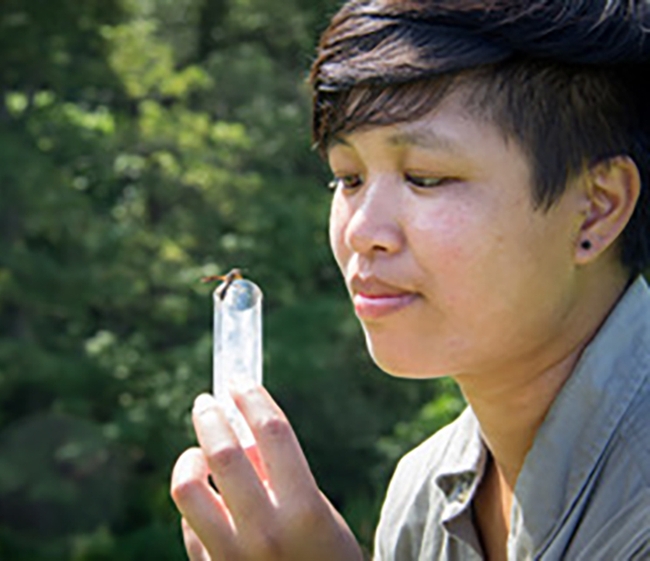
She's the little Concord, Calif., kindergarten student who declared--on the very first day of class-- "When I grow up, I want to be an entomologist!"
And she did.
RJ received her bachelor's degree in entomology in 2021 from the University of California, Davis, and then accepted a four-year, full-ride fellowship offer to complete a doctoral program at the American Museum of Natural History (AMNH). She's a doctoral candidate of comparative biology in the Richard Gilder Graduate School at AMNH and studies in the lab of Professor Jessica Ware.
RJ studies the twisted-wing parasites, order Strepsiptera. As larvae, they enter their hosts, including wasps, bees and cockroaches, through joints or sutures.
Fast forward to today. Her newly published research, “Collection Methods and Distribution Modeling for Strepsiptera in the United States,” is the cover story in the August issue of the journal, Environmental Entomology.
It's not often that an entomologist's first published doctoral research scores the cover of an academic journal.
The cover image shows a parasitized northern paper wasp, Polistes fuscatus, with three male Xenos peckii pupae visible in its abdomen. The image is the work of John and Kendra Abbott of Abbott Nature Photography, Tuscaloosa, Ala.
“The twisted-wing insect parasite order (Strepsiptera) is an excellent example of how beautifully complex evolution and life's interconnectedness can be,” RJ says. “These obligately endoparasitic insects infect several other major orders of Insecta, including true bugs, mantises, cockroaches, flies, wasps, crickets, and even silverfish. Because of this, they can be very difficult to find and study.”
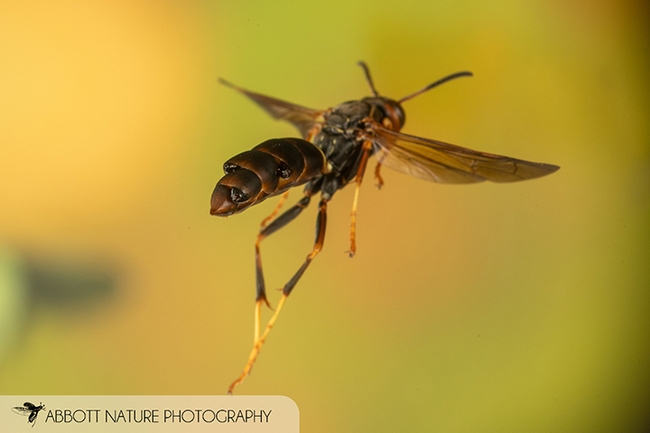
She became interested in the twisted-wing parasites while studying for her entomology degree at UC Davis. In 2019, she was one of four UC Davis undergraduates selected for a two-year funded research career with the University of California Leadership Excellence through Advanced Degrees (UC LEADS) program, which prepares promising students for advanced education in science, technology, mathematics and engineering (STEM). The UC LEADS scholars embark upon a two-year program of scientific research and graduate school preparation.
Guided by UC Davis Distinguished Professor Jay Rosenheim (now an emeritus), RJ launched her independent research project on those bizarre Strepsiptera endoparasites that attack their hosts, the Ammophila (thread-waisted) wasps. Over a two-year period, she studied thousands of specimens at the Bohart Museum of Entomology.
The Bohart Museum houses a worldwide collection of eight million specimens, including “about 30,000 specimens of Ammophila from multiple continents,” according to UC Davis Distinguished Professor Emerita Lynn Kimsey, who directed the museum for 34 years before retiring Feb. 1, 2024, Global wasp authority and UC Davis doctoral alumnus Arnold Menke, author of the book, The Ammophila of North and Central America (Hymenoptera, Sphecidae), identified most of the Ammophila specimens in the Bohart Museum. His book is considered "the bible" of Ammophila research.
RJ went on to enter a poster, “Parental Care and the Risk of Maternally Vectored Pathogens: Ammophila Transmit Strepsipteran Parasites to Their Young,” in the March 2021 Koret UC LEADS Symposium poster competition and won top honors.
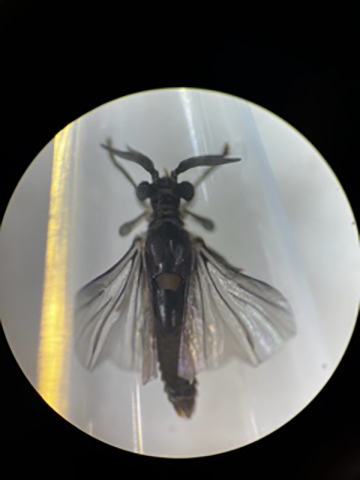
And now, her paper in the Environmental Entomology journal is online at
https://academic.oup.com/ee/issue/53/4.
In their introduction, RJ and her team wrote that Strepsiptera “have a cosmopolitan distribution, but they can be difficult to collect for many reasons. As the larval stages are obligate endoparasites of other insects, strepsipterans are necessarily restricted to the ranges of their hosts and may have patchy distributions among host populations. The neotenic females dwell permanently within the abdomens of their insect hosts, with the exception of some members in the family Mengenillidae. Male strepsipterans can be collected independently of their hosts once they eclose and enter the free-flying adult stage.”
“However, they are likely to still be found within their host ranges since they live for only a few hours and must mate within that time. Females and males range from 0.5 to 5 mm and can be easily overlooked in host abdomens (females) or malaise traps There are no standard procedures for the collection of Strepsiptera, since they parasitize such a wide variety of insect hosts—they are documented to parasitize 7 orders comprising approximately 36 insect families, and these hosts inhabit many different environments.”
Co-authors are Anna Eichert, a doctoral candidate of comparative biology in the Ware lab, and Ware, an AMNH evolutionary biologist and curator. Millena credited Kathy LaPoint of Black Rock Forest, Cornwall, N.Y., for images “taken during our collecting trips,” and Abbott Nature Photography for images of a male Xenos peckii in flight and an Isodontia mexicana parasitized by Eupathocera auripedis.
“My work on the evolution and biology of these tiny insects,” Millena said, “is motivated by how much I want everyone to appreciate the unfathomably intricate lives of the organisms we take for granted every day.”
Well said, and well done!
Attached Images:
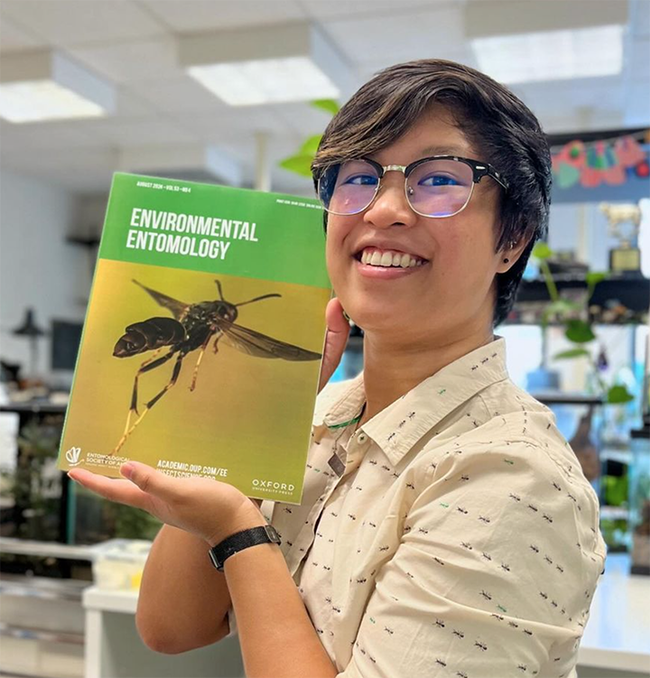
RJ Millena, a doctoral candidate of comparative biology in the lab of Professor Jessica Ware, American Museum of Natural History (AMNH) holds a copy of the journal "Environmental Entomology." Her research is the cover story. (Photo by UC Davis alumnus Lohit Garikipati, now a doctoral student at AMNH)
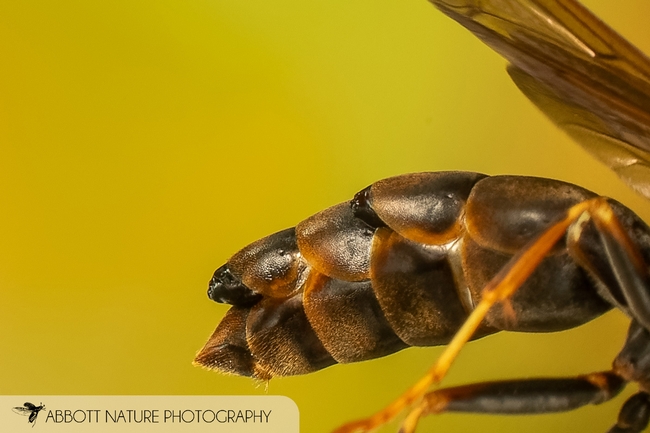
This image shows a twisted-wing insect (Xenos peckii) male pupae in dark paper wasp (Polistes fuscatus) (Abbott Nature Photography)
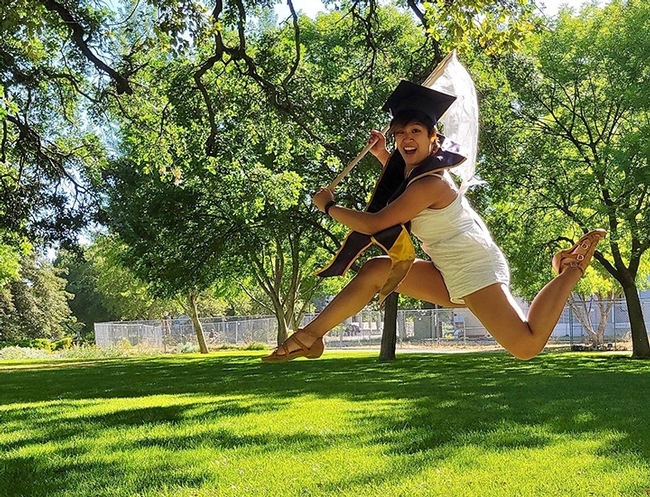
This image of UC Davis entomology graduate RJ Millena shows her jumping for joy while wielding an insect net. (Photo taken in 2021 by Kaylee Fagan)